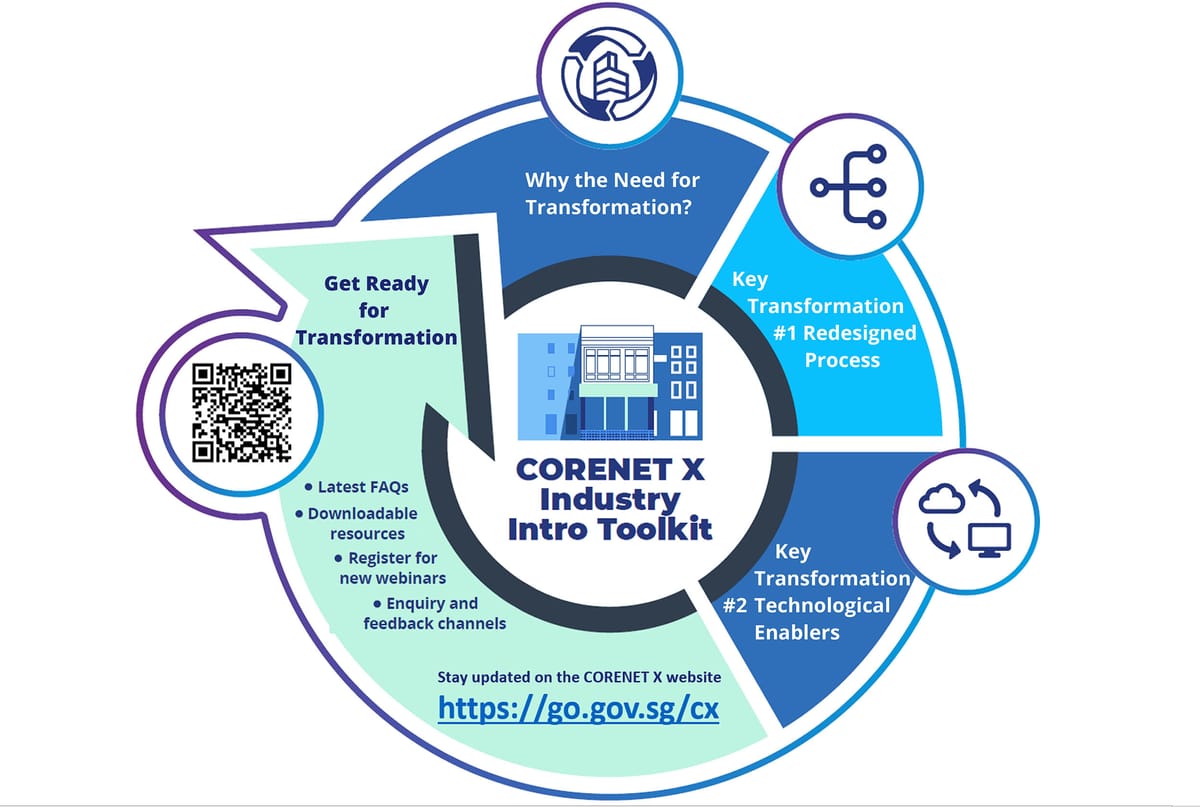All you need to know about regulatory submissions for CorenetX
This article examines the key features of the CorenetX system and its impact on project owners, engineering consultants, and contractors.

Regulatory compliance to the complex web of building codes remains a challenge in the built-envrionment sector. CorenetX, an initiative by the Building & Construction Authority (BCA) of Singapore, aims to unify the regulatory submission requirements from multiple agencies into a single submission gateway.
CorenetX represents a significant upgrade from the existing Corenet 2.0 system, which is widely used for building plan submissions. CorenetX represents a significant shift in how regulatory submissions are made from 2D to 3D.
This article examines the key features of the CorenetX system and its impact on project owners, engineering consultants, and contractors.
The CorenetX Platform: Transitioning from 2D drawings to 3D BIM submissions
The technology powering CorenetX is openBIM, formerly known as IFC. IFC acts as a universal language, facilitating the exchange of design data among various BIM applications (i.e. Revit, ArchiCAD, OpenBuildings), thus enabling collaboration between the trade contractors.
A key development in Singapore's adaptation of this system is the introduction of the IFC-SG format, a localized variant of the globally recognized IFC4.
IFC-SG introduces a set of object parameters, fostering multi-agency collaboration on the BIM model. This integration allows the BCA to conduct automated model checks and significantly reduces the number of "gateways" required for permit issuance.
Improvements in BCA's regulatory submission workflows with CorenetX
The previous Corenet2.0 system involved up to 20 different approval touchpoints across various regulatory bodies. CorenetX has streamlined this to just three primary submission gateways:
- Design Gateway
- Construction Gateway
- Completion Gateway
Initial challenges are expected, but overall, the process of obtaining permits and approvals is anticipated to become much faster.
What is the impact of CorenetX to consultants and contractors?
While CorenetX and IFC-SG hold tremendous promise, it's important to note the following to comply with regulatory requirements:
1. Greater need for upfront BIM modelling before the initial design submission
The promise of an integrated response from the multiple regulatory agencies shows great promise in reducing the lead times for design approvals. However, it also means that engineering consultants need to work more closely with trade models to work towards a complete BIM model earlier in the design phase.
Under the previous system (i.e. Corenet 2.0), engineering consultants could afford to delay the (BIM) submissions, giving contractors more time to perform the BIM modelling works as the submission gateways are more spread out. This is no longer possible.
When we work on projects for BIM delivery, we emphasize the use of virtual design reviews to faclitate the BIM coordination process between consultants and trade contractors. This way, BIM models from trade contractors can be federated with the design BIM model earlier on where issues (i.e. clashes, energy performance data) can be identified.
A secondary benefit to planners and consultants is that they can leverage all this upfront data to perform analytical & simulation workflows to further mitigate project risks.
2. Updating BIM objects to IFC-SG format
Submissions through CorenetX typically require the openBIM format. 2D CAD formats such as AutoCAD(.dwg), MicroStation(.dgn), and PDF(.pdf) are no longer the primary method of file submissions. The industry needs to start converting their existing 2D CAD drawings to BIM .
Also, the BIM data formats that the industry is most familiar with are no longer accepted. This includes 3D file formats like Revit, ArchiCAD, OpenBuildings, and Tekla. Instead, 3D BIM models need to be exported in IFC-SG format which can be found in the industry mapping template provided by BCA.
In a typical CorenetX submission, the regulatory agencies will provide an coordinated response within 20 working days. To reduce the risk of project delays, consultants can consider the use of automated model checkers to visually check their BIM models for issues. This is to avoid minor issues (i.e. missing IFC-SG parameters) from preventing approvals to begin construction.
Alternatively, consultants and contractors can choose to work with our experienced BIM team to perform building plan submissions as well as other digital delivery workflows related to their project.
3. Leverage BCA's resources for IFC Learning
Understanding IFC-SG is crucial for success. Essential resources include:
- IFC-SG Resource Kit: A detailed guide for different BIM software, covering FAQs and IFC-SG submissions.
- IFC-SG Validator: A tool to detect missing IFC-SG parameters in BIM models.
- Service Providers: Expert services for custom IFC-SG parameter setup can ensure accurate configuration and prevent future complications.
Clients who are keen on upskilling their own teams on IFC-SG can register their colleagues in Skillsfuture-funded courses on IFC-SG.
What to expect for CorenetX
Mandatory BIM submissions through CorenetX are expected to commence in Q1 2025. In the interim, clients can make voluntary submissions to the CorenetX platform to test their BIM workflows. While we anticipate some initial teething issues with the rollout of CorenetX, we are confident in the overall benefits it will bring to the built-environment supply chain.
